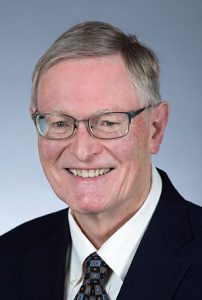
James Hill
Title(s):
University Professor Emeritus
Office
2121 Sweeney
618 Bissell Rd.
Ames, IA 50011-1098
Information
Education
Interest Areas
Research Interests: Fluid mechanics; turbulence; transport phenomena; reacting flows; computational fluid dynamics.
Research Projects: We are studying problems of turbulent transport and mixing using statistical theory, direct numerical simulation, large eddy simulations, stochastic modeling, and laboratory experiments. These studies help to clarify the role that molecular properties play in turbulent transport processes, test closure theories that are candidates for engineering models, particularly in CFD (computational fluid dynamics) applications, and to discover new features of some simple turbulent flows.
Mixing and Chemical Reaction in Homogeneous Turbulent Flows: In previous studies we have shown by direct numerical simulation the importance of the least principle strain rate in determining the course of a chemical reaction. Currently we are studying turbulent mixing and transport in a model planar-jet reactor, using stochastic modeling and large eddy simulation, and carrying out experiments using stereo-particle image velocimetry (SPIV), planar laser induced fluorescence (PLIF), and laser Doppler velocimetry. Simultaneous PIV/PLIF allows direct measurement of turbulent transport rates to compare with simulations. A two-step reaction scheme is now being developed in order to test engineering and stochastic models for use in CFD applications. The results are expected to be applicable to industrial chemical reactors, combustion, and air pollution modelling.
Scalar Transport in Homogeneous Turbulent Flows: Two-point moment closure theory, linear theory, and direct simulations are being applied to the problems of heat transfer in isotropic turbulence, the decay of turbulence in a stratified fluid, transport and mixing of multiple scalars in turbulent flow, and rotational effects. The theories are self-consistent and allow the prediction of turbulent transport coefficients without laboratory experiments. In the stratified flow study, the conditions for the existence of “active” and “fossil” turbulence have being determined, and for the passive scalar problem it has been found that spectral scale matching can be used to obtain quantitative agreement with laboratory experiments. Applications include the development of better engineering models for turbulent heat transfer and improved understanding of stratified turbulent flows that occur in nature and in some industrial processes.
Publications
- Hua, F., Olsen, M. G., Liu, Y., Fox, R. O., and Hill, J.C., “Investigation of Turbulent Mixing in a Confined Planar-Jet Reactor,” AIChE J ., 51 , 2649-2664 (2005). http://dx.doi.org/10.1007/s00348-007-0265-7
- Gokarn, A., Battaglia, F., Fox, R. O., and Hill, J. C., “Simulations of Mixing for a Confined Co-flowing Planar Jet,” Computers and Fluids , 34 , xxxx (2005).
- Fox, R. O. and Hill, J. C., “Models for turbulent micromixing in systems with complex chemistry,” Proceedings 3 rd International Symposium on Advanced Energy Conversion Systems and Related Technologies, Nagoya, Japan, 2001.
- Hill, J. C., Sanderson, R. C., and Kaneda, Y., “Direct Interaction Approximation for Transport of Active and Passive Scalars in Homogeneous Turbulent Flows,” Bull. Amer. Phys. Soc. , 44 (8), #DB.07 (1999).
- Chakrabarti, M. and Hill, J. C., First Order Closure Theories for a Series-Parallel Reaction in a Simulated Homogeneous Turbulence, AIChE J ., 43 , 902-12 (1997).
- Hill, J. C. and Petty, C. A., Turbulent Transport of a Passive Scalar Field, Chem. Eng. Commun ., 152-153 , 413-432 (1996).
- Leonard, A. D., Hamlen, R. C., Kerr, R. M., and Hill, J. C., Evaluation of Closure Models for Turbulent Reacting Flows, Ind. Eng. Chem. Research , 34 , 3640-3652 (1995).
- Chakrabarti, M., Kerr, R. M., and Hill, J. C., Direct Numerical Simulation of Chemical Selectivity in Homogeneous Turbulence, AIChE J. , 41 , 2356-2370 (1995). http://dx.doi.org/10.1002/aic.690411103